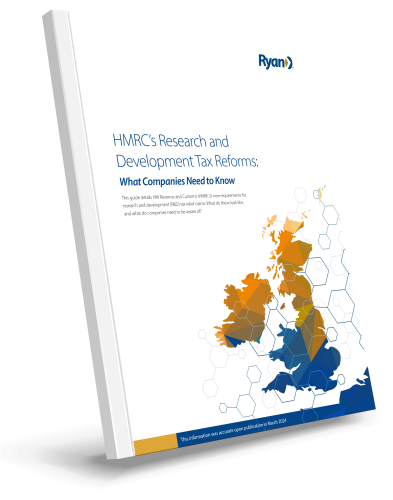Research and Development Tax Relief
Is your company engaged in research and development (R&D) activities? Are you looking to unlock valuable financial benefits and incentives? Our R&D tax relief services help your company maximise its tax savings and fuel innovation within your organisation. By leveraging the power of R&D tax relief, you can drive growth, increase your cash flow, and stay at the forefront of your industry.
What Is R&D Tax Relief?
Is My Company Eligible for R&D Tax Relief?
To qualify, a company must be seeking a technological or scientific advance within its industry. It’s important to note that this does not have to be a successful project that becomes operational, nor does it have to be a completed project.
If your company has developed a new technological or scientific process, product, or service, or modified an existing one, it could be eligible for R&D tax relief.
For many years, both the SME and RDEC schemes for R&D tax relief remained very stable, except for periodic small changes in the RDEC rate. From Autumn 2022 onwards, a whole series of changes was announced and re-announced with incremental further changes. Some take effect for all companies incurring R&D expenditure on or after 1 April 2023, other changes are dependent on the month a company’s accounting period (AP) begins, and whether this is on or after 1 April 2023 or 1 April 2024 onwards.
Changes Relating to Accounting Periods Beginning on or After 1 April 2023 (All R&D Schemes)
Companies Need to Notify HMRC in Advance
What Companies Must Give Advance Notification?
Any company that has not made a claim before will need to notify by the claim notification deadline. There are some exemptions that allow companies who have submitted eligible claims (based on the submission date of the R&D claim to HMRC), within three years of the claim notification period deadline, not to notify. However, this exemption does not include all claim submissions.
Any company that has made an R&D claim submission to HMRC in the three years before the claim notification deadline for the period being reviewed may consider the submission as part of the exemption if:

- The claim submission was made before 1 April 2023, or
- For claim submissions made after 1 April 2023, they must either:
- Be made as part of the original tax return submission or
- Be for a period starting on or after 1 April 2023
As the exemption is complicated, we recommend talking to an adviser as early as possible when considering undertaking an R&D project. If your company does not get timely advice on claiming R&D tax relief, it could miss the claim notification deadline and lose out.
HMRC’s Additional Information Form
From 8 August 2023, HMRC made it mandatory for all businesses claiming R&D tax relief to submit an additional information form, regardless of the AP being claimed for.
What Additional Information Is Needed?
Before the change, the provision of project information and cost analysis was recommended but optional. Now, HMRC requires firms to include the following before submitting their corporation tax returns:
Discover how Ryan's Q&A guide simplifies the new claim notification form and process—read the full article here.
Changes Relating to Accounting Periods Beginning on or After 1 April 2024
Merged R&D Scheme: A New Single Scheme for SMEs and Large Companies
Enhanced R&D-Intensive Support (ERIS) Scheme
Despite the vast majority of companies claiming under this scheme, loss-making R&D-intensive SME claimants will have a separate scheme, known as ERIS, which stands for “Enhanced R&D-Intensive Support.” For APs beginning on or after 1 April 2024, the R&D intensity threshold (see earlier) will fall to 30% (previously 40% from 1 April 2023), and a one-year period of grace applies where the SME does not meet the intensity threshold for the period but did in the previous period, allowing it to again claim under the ERIS scheme. The support given through the ERIS scheme will be the same as that provided in the old SME scheme to R&D-intensive companies allowing eligible losses to be surrendered 14.5% and subject to the same PAYE cap as the new merged scheme .
Ryan’s Comprehensive R&D Tax Relief Solutions
FREE DOWNLOAD HMRC’s R&D Tax Reforms: What Companies Need to Know
Download a copy of our guide “HMRC’s R&D Tax Reforms: What Companies Need to Know” for a comprehensive overview of the R&D tax relief schemes.

Why Ryan?

Expertise and Experience
Our team of R&D tax specialists has in-depth knowledge and experience in maximising R&D tax relief. We stay up to date with the latest regulations and guidelines to provide you with accurate and reliable advice.
Time and Cost Savings
Outsourcing your R&D tax relief management to us allows you to save valuable time and resources. Our streamlined processes and expert guidance minimise the administrative burden, enabling you to focus on your core business activities.


Increased Cash Flow and Innovation
By optimising your R&D tax relief claims, you can generate substantial cash flow and reinvest the savings into further innovation. This fuels growth, enhances your competitive edge, and positions you as an industry leader.
HMRC R&D Statistics 2023
HM Revenue and Customs (HMRC) releases annual statistics revealing how its research and development (R&D) tax relief scheme has been used by UK companies. Our experts analyse these statistics to spot trends in the scheme’s usage, so we can support as many companies as we can. The stats delve into average claim values, usage by sector, and regional data on both the number and value of claims.
We have picked out some of the more interesting insights and prepared analysis of our own, from the most recent statistics for the tax year 2021-2022. There is also a link to the source data for those who want a more in-depth look.
Am I Eligible for Innovation Funding?
Evaluate your eligibility, receive tailored advice, and transform your business.
Discover your funding potential with our free innovation funding assessment tool.







